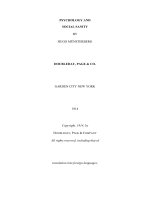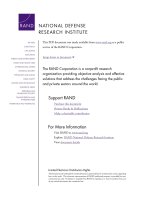educational psychology
Bạn đang xem bản rút gọn của tài liệu. Xem và tải ngay bản đầy đủ của tài liệu tại đây (30.25 KB, 2 trang )
Educational Psychology ? Mr. ? Psychology 16 Oct.
1996?Mr. ?Psychology16 Oct. 1996 Educational Psychology The
field of psychology that deals with the ability to solve educational
problems and to improve educational situations is the field of educational
psychology. Educational psychology is sometimes referred to as an
applied field, meaning, one in which the objective is to solve immediate
practical problems (James 29). The beginnings of educational
psychology were initiated by Aristotle in his formulation of the laws of
association. These laws: similarity, contrast, and contiguity,
supplemented by frequency, are the beginnings to an experimental
science (Piaget 9). As the science began to develop, the educational
psychologists did little more than administer mental tests, which started
with the Stanford-Binet test (IQ test). Today, the science has been
expanded to include counseling students, teachers, administrators, and
parents, in an effort to help make the school environment one which is
most effective in promoting learning. As an example, if a student in
school commits a disciplinary action, instead of being indiscriminately
punished, that student would be sent to see the school psychologist to
find out the causes of the students misbehavior and deal with them
accordingly (Frandsen 92).Though studies of educational surveys, there
were nine major factors that increased learning. These nine factors can
be placed into three groups: student aptitude, instruction, and
psychological environments. Student aptitude includes (1) ability or prior
achievement as measured by score on educational test; (2) development
as indexed by chronological age or stage of maturation; and (3)
motivation or self-concept as shown by personality tests and students'
perseverance on learning tasks. Instruction can be thought of as (4) the
amount of time students engage in learning and (5) the quality of the
instructional experience. Psychological environments include: (6) the
"curriculum of the home," (7) the morale of the classroom social group,
(8) the peer group outside school, and (9) the amount of leisure-time
television viewing. These are the factors that influence academic
achievement and behavioral learning (A.A.E. 66). Educational
psychology does not only hold true for humans, but also for animals. Ivan
Pavlov displayed the principle of association by applying it to the salivary
reflex. He trained his dogs to salivate at the sound of a bell alone if
previously they had so responded to meat and the bell together. In
another case, B. F. Skinner trained pigeons to play a form of table tennis
by rewarding the birds with food pellets each time they hit a ball into a
designated trough (James 66). This area of psychology is used today
to teach specific subjects such as foreign languages, arithmetic and
mathematics, reading, writing, spelling, and the sciences. However,
teaching of these subject requires a person that displays "readiness."
This "readiness" is most commonly found in early ages and the older one
is, the less "readiness" they have to learn (Frandsen 2). Psychology
is still a young science, and human nature is exceedingly complex.
However, in the educational setting it has made remarkable advances in
the past half century or more, though the cultural lag has delayed many of
the advantages that might otherwise have accrued. With the
development of television and of lesson programming for teaching
machines, coupled with a public awakening, dramatic and revolutionary
changes may be expected in the foreseeable future (Piaget 179+180).
Works CitedAcademic American Encyclopedia (A.A.E.). Danbury,
Conn.: Grolier Incorporated, 1993.Frandsen, Arden N. How Children
Learn. New York: McGraw-Hill Book Company, Inc., 1957.James,
William. Talks To Teachers. New York: Henry Holt and Company,
1900.Piaget, Jean. Science of Education and the Psychology of the
Child. New York: Orion Press, 1970.









